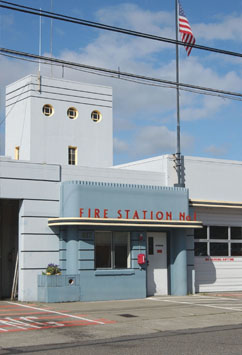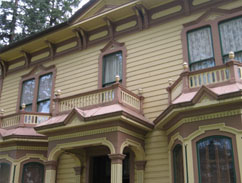Survey Levels
 Architectural surveys fall into two general classifications: intensive and reconnaissance levels. Both types have a place, depending on the amount of information to be collected, the time and budget available, and the geographic dispersion of the resources. Reconnsissance level surveys are the most common and are typically used for Section 106 consultation, and initial survey work in a previously undocumented area. All survey forms must still be completed using the Wisaard system.
Architectural surveys fall into two general classifications: intensive and reconnaissance levels. Both types have a place, depending on the amount of information to be collected, the time and budget available, and the geographic dispersion of the resources. Reconnsissance level surveys are the most common and are typically used for Section 106 consultation, and initial survey work in a previously undocumented area. All survey forms must still be completed using the Wisaard system.
Reconnaissance Level
The Reconnaissance Level Survey (RLS) is designed as a “first-look” at a broad group of historic resources and records basic information that is collected from the exterior of a building only. Information collected through a RLS is assembled in a final report. Reconnaissance surveys are visual or predictive surveys that identify the general distribution, location and nature of cultural resources within a given area. Documentation at this level rarely exceeds property address, observational information on architectural style and features, and photographic information. However based on the skill and expertise of the surveyor it should be possible to discern if a property appears to be connected to a larger context and the merits of its architecture. This information should be recorded in the “Statement of Significance” section of the database. Note that reconnaissance surveys are often conducted to establish the boundaries for intensive surveys to follow.
Reconnaissance surveys consist of walking around an area and noting the general distribution of buildings, structures, and neighborhoods representing different architectural styles, periods and modes of construction. Because reconnaissance surveys record only observable information, they may not provide sufficient information with which to make determinations of eligibility beyond architectural significance.
A reconnaissance level survey should include the following:
- Resource name - either the historic name, if known or a generic name that describes the resource, i.e. residence, commercial building, gas station, etc...
- Property type
- Location information sufficient to find the property if one were looking for it in person or on a map
- Surveyor and survey name
- Date recorded
- Current use of the building should be noted since it is observable from the street
- Historic use, if apparent from the building type
- Historic Context
- A discussion of the seven aspects of integrity
- All observable architectural information (characteristics & styles)
- Description of Physical Appearance section on the Narrative must be completed
- Changes to Structure should noted in pulldown menu
- Statement of Significance - based on the knowledge of the surveyor and what you can gather from the street, briefly discuss the National Register criteria and clearly indicate how and why a resource does or does not meet National Register criteria (Click here for example)
- Determination of Eligibility opinion - Fill in the boxes which denote if the resource eligible for listing in the National Register either individually or part of a district?
- Approximate date of construction
- Digital image(s) of the resource
A reconnaissance level survey does not need to include the following:
- National, State or Local Register status
- The historic use of the property
- The architect/engineer/builder
- An in-depth Statement of Significance which addresses the NR criteria which iinvolves in-depth research
- A bibliography (unless sources were consulted by the surveyor)
Intensive Level
Intensive Level Survey (ILS) and evaluation combines a reconnaissance survey with a deeper evaluation based on sound research. The ILS is a detailed look at a single resource and records in-depth information collected from a physical examination of a building’s exterior and sometimes the interior. It also includes research about the building’s use and ownership history. Information collected through an ILS provides a solid basis for individual, historic district, and/or multiple property National Register nominations.  An intensive level survey should include the completion of all of the fields on the database and would consist of research on the property beyond what can be noted from the street.
An intensive level survey should include the completion of all of the fields on the database and would consist of research on the property beyond what can be noted from the street.
A intensive level survey should include all of the information required for a reconnaissance level survey plus the following:
- An accurate build date based on research
- Historic images if found
- The name of the architect or builder
- A more complete photographic documentation of the building
- A bibliography
- The historic use of the property
- A discussion of the seven aspects of integrity
- Ownership information
- Historic or common name of the property
- A thorough, in-depth statement of significance section based on the history of the resource and its context using primary and secondary sources. The narrative should clearly spell out how and why a resource does or does not meet National Register criteria A, B, C & D.
If you have any questions or concerns, feel free to contact Michael Houser at 360-584-2436 or at Michael.Houser@dahp.wa.gov.




